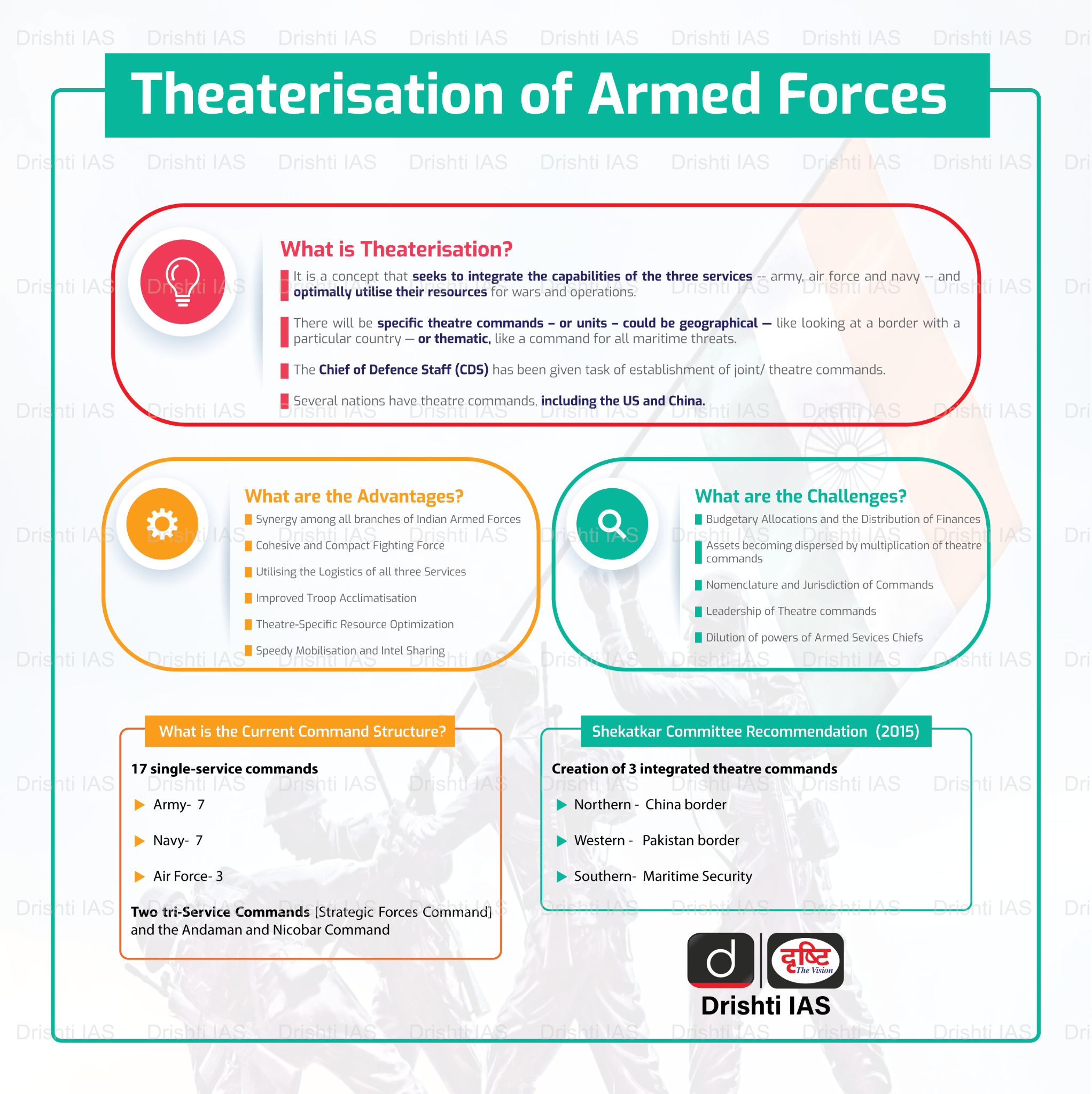Integration Among Defence Forces | 13 Oct 2023
For Prelims: Chief of Defense Staff (CDS), Artificial Intelligence (AI), GSAT-7B, ISRO, Light Combat Aircraft (LCA), LCA-Mk1A,
For Mains: Benefits of rationalisation of Indian defense forces on overall internal security and external threats to the country.
Why in News?
Recently, the Chief of Defence Staff (CDS) highlighted that nine verticals have been identified for integration among three defense services which includes logistics, intelligence, information flow, training, administration, supply chain management and maintenance etc. among others.
- The process of ‘theatrisation’, part of a reorganization effort undertaken by the armed forces, which will be fulfilled through integration of the defense forces and the creation of Integrated Theatre Commands.
What is the Integration Among Three Defense Services ?
- Integration of three defense services in India involves establishment of Integrated Theatre Commands (ITCs), office of the Chief of Defense Staff, Cyber and Space Commands, and resource sharing and joint training and exercises among others.
- Integrated Theatre Command:
- An integrated theatre command envisages a unified command of the three Services, under a single commander, for geographical theatres (areas) that are of strategic and security concern.
- The commander of such a force will be able to bear all resources at his disposal — from the Army, the Indian Air Force, and the Navy — with seamless efficacy.
- The integrated theatre commander will not be answerable to individual Services.
- Integration and jointness of the three forces will avoid duplication of resources. The resources available under each service will be available to other services too.
- The services will get to know one another better, strengthening cohesion in the defense establishment.
- The Shekatkar committee has recommended the creation of 3 integrated theatre commands — northern for the China border, western for the Pakistan border, and southern for the maritime role.
- Joint Command in Andaman & Nicobar islands:
- There is one joint command in Andaman and Nicobar Islands.
- It is the first Tri-Service theatre command of the Indian Armed Forces, based at Port Blair in the Andaman and Nicobar Islands of India.
- It was created in 2001 to safeguard India's strategic interests in Southeast Asia and the Strait of Malacca by increasing the rapid deployment of military assets in the islands.
- There is one joint command in Andaman and Nicobar Islands.
- The other tri-service command, the Strategic Forces Command (SFC), looks after the delivery and operational control of the country’s nuclear assets.
- Current Situation:
- The Indian armed forces currently have 17 commands. There are 7 commands each of the Army and the Air Force. The Navy has 3 commands.
- Each command is headed by a 3-star rank military officer.
What are the Recent Developments in Integration Among the Three Services?
- The appointment of the CDS and the creation of the Department of Military Affairs (DMA) are momentous steps towards the integration and advancement of defence forces.
- Work exclusively pertaining to military matters will fall within the purview of the DMA. Earlier, these functions were the mandate of the Department of Defence (DoD).
- CDS: It is the single-point military adviser to the government as suggested by the Kargil Review Committee in 1999.
- It oversees and coordinates the working of the three Services.
- As the head of DMA, CDS is vested with the authority in prioritizing inter-service procurement decisions.
- Significance of CDS:
- Synergy between Armed forces and Government: CDS fosters better cooperation between the Ministry of Defense bureaucracy and the Armed services.
- Jointness in operations: Erstwhile Chiefs of Staff Committee-COSC has been made dysfunctional as CDS promotes more jointness in operations.
- Concerns of Indian Air Force (IAF):
- While the army and navy are in favour of theatre commands, the IAF has concerns about the model over the division of its air assets, the nomenclature of commands, the leadership of theatre commands and dilution of powers of chiefs.
- New Uniforms:
- All officers of the rank of Brigadier, Maj General, Lt General, and General will wear berets of the same colour, common badges of rank, a common belt buckle, and a common pattern of shoes, and will do away with the lanyards on the shoulders.
- Recently, Inter-Services Organisations (Command, Control and Discipline) Bill, 2023, was introduced in Lok Sabha to empower designated military commanders to take charge of soldiers and enforce discipline, regardless of the service they belong to.
Inter-Services Organisations (Command, Control and Discipline) Bill, 2023
- The system is likely to include five joint services commands - western, eastern, northern, maritime, and air defense.
- The central government may constitute an Inter-services Organisation, which may include a Joint Services Command.
- It will empower the Commander-in-Chief/the Officer-in-command of Inter-Services Organisations to maintain discipline and ensure proper discharge of duties of all the personnel from the army, navy and IAF serving under his command.
- The Commander-in-Chief or the Officer-in-Command of an Inter-services Organisation shall be the head of such Inter-services Organisation.
UPSC Civil Services Examination Previous Year Question (PYQ)
Prelims
Q. Department of Border Management is a Department of which one of the following Union Ministries? (2008)
(a) Ministry of Defence
(b) Ministry of Home Affairs
(c) Ministry of Shipping, Road Transport and Highways
(d) Ministry of Environment and Forests
Ans: (b)
Mains
Q1: Analyze the multidimensional challenges posed by external state and non-state actors, to the internal security of India. Also discuss measures required to be taken to combat these threats. (2021)
Q2: Analyze internal security threats and transborder crimes along Myanmar, Bangladesh and Pakistan borders including Line of Control (LoC). Also discuss the role played by various security forces in this regard. (2020)
Q3: Border management is a complex task due to difficult terrain and hostile relations with some countries. Elucidate the challenges and strategies for effective border management. (2016)

